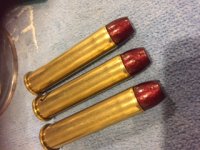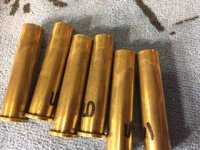Yes, the bulge is reasonable if you resized the case. The factory puts a taper on the case, but a lot of dies make them straighter than that. A long bullet can get far enough down in the taper to show no real bulge, but a short one won't. Figure the brass is sized to make the brass about 0.001–0.002 inches smaller than a jacketed bullet to achieve adequate bullet grip, so jacketed bullets would bulge about 0.001–0.002 inches, and that your cast bullets with coatings are about 0.001-0.002 inches bigger than the jacketed ones are, getting you to 0.003" bulge. Nothing unusual.
The bulge (mirroring of the bullet base location) is actually useful to evaluate how straight you are seating the bullets. If they are straight, the bulge will be pretty even all around. If they are not, the bulge will be sometimes only on one side. They are almost never perfectly even all around because brass case walls are not dead evenly thick all around, except by happy accident. But gross unevenness lets you know you need to flare with a Lyman M style expander die (Redding and, I think, Hornady makes their straight wall case expanders this way).
The velocities and SD's give the impression you are operating at lower pressure than the powder likes. When I put Hodgdon's data for a 300 grain lead flat point bullet either into QuickLOAD with some burn rate adjustment, or into a spreadsheet I have that calculates pressure and velocity from the exponential relationships in the Hodgdon data, your two 4198 loads should be producing about 1610 and 1700 fps if your chamber and barrel were as tight as Hodgdon's test barrel's is. It won't be. But I'd still expect to make 95% of their number even with a loose gun, and and 97-98% or so to be typical of production guns. I see your smaller load made 1574 on one shot, and that's almost 98% and reasonable.
So, then, why aren't the other rounds behaving quite so well? You didn't say how close the chronograph is. When you have loads like these that, even when they fire well, dump about 10-15% of the powder out unburned, it common to get false low reading from them on an optical chronograph. A Magnetospeed or a LabRadar would not. The reason is neither of those two devices can register powder particles while an optical unit can. When the bullet clears the muzzle, the gas accelerates to about 1.4 to 2 times the bullet velocity. That can throw some powder particles out ahead of the bullet for a short distance. They lose velocity very quickly, as they are light and not aerodynamically shaped for low drag, but they can sometimes get to the first chronograph screen and trigger it an inch or so ahead of the bullet, which then passes them a gets to the stop screen first. This makes the time between front and rear screen triggering long and gives a false slow reading, but no error message of any kind. Muzzle blast rattling the diffusers can also cause false triggering.
The cure for both is the same. More distance. We had a board member with a 338 Lapua Magnum who had to get all the way out to 18 feet before the readings became consistent. Usually, 15 feet is enough. But a lot of chronographs have 10 foot cables to a remote display or just get hard to read without binoculars out past that range, so that's as far as some go. For handguns, that's fine, but rifles can cause problems with it.
If we assume the chronograph readings are right, something is going seriously wrong with ignition. That is, some bullets are getting too far down the tube before the powder really gets a good burn going, so its building pressure late and in too much space. Why? Several factors could be contributing. Powder position is one. These loads are low percent case fill. I looked at the bullet photo on line and it looks like its seats less than a caliber into the case when the crimp groove is lined up with the case mouth. About 70% or less case fill. In some cartridges you can get over 100 fps difference in velocity just depending whether the powder is over the flash hole or over the bullet with that kind of case fill. If you didn't position the powder carefully over the primer by tipping the muzzle up between shots, that could be a big piece of the puzzle. A disc of paper over the powder or a tuft of polyester pillow ticking can help. Just be sure you work up from lower down when you add things to the case that affect the amount of air space in it.
With low case fill, going to a magnum primer can help a good deal. Magnum primers make more gas, and that can help reach adequate start pressure with all the extra room in there.
Coated bullets are pretty well lubricated. Lubrication reduces how much resistance there is to build pressure against, and an extra grain or two of powder is commonly needed to make up the velocity loss you otherwise get.
Lubrication also makes a bullet slip in and out of the case more easily, so you need to be extra careful to get a good crimp. I recommend the Redding Profile Crimp die for a roll crimp into the crimp groove. It holds the sides to resist the rolling in of the crimp expanding the brass below it and spoiling the case neck's friction hold on the bullet.
Lots to think about and try.






